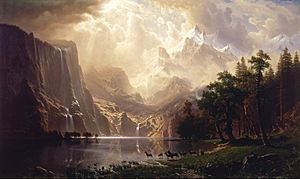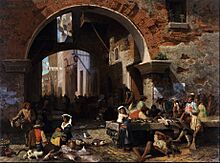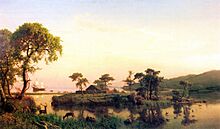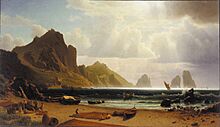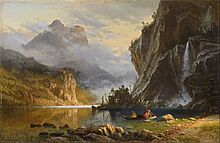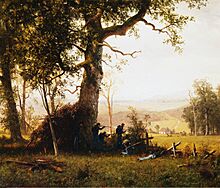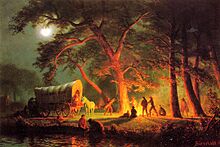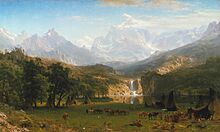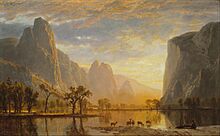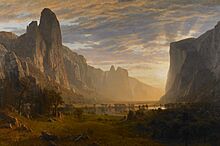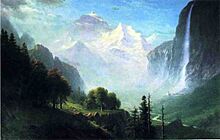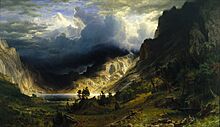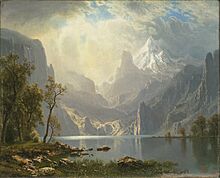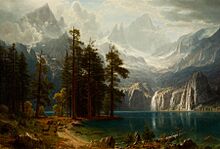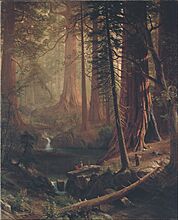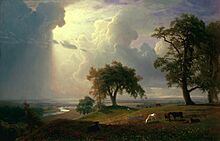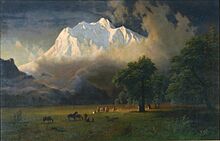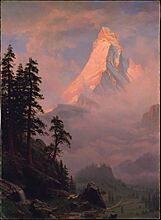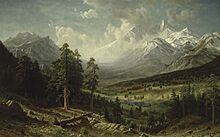Albert Bierstadt facts for kids
Quick facts for kids
Albert Bierstadt
|
|
|---|---|
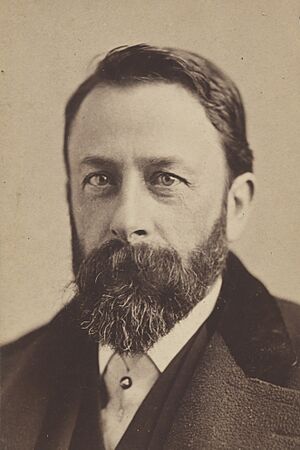
Portrait by Napoleon Sarony, c. 1870
|
|
| Born | January 7, 1830 |
| Died | February 18, 1902 (aged 72) New York City, U.S.
|
| Nationality | American |
| Education | Düsseldorf School |
| Known for | Painting |
|
Notable work
|
List of works |
| Movement | Hudson River School |
Albert Bierstadt (born January 7, 1830 – died February 18, 1902) was a famous German American painter. He is best known for his amazing, large paintings of the American West. He traveled on many trips to the West to paint these beautiful scenes. While he wasn't the first artist to paint these places, he became the most important painter of the American West in the 1800s.
Bierstadt was born in Prussia, which is now part of Germany. His family moved to the United States when he was just one year old. Later, he went back to Germany to study painting for several years. He became part of the Hudson River School in New York. This was a group of artists who painted stunning landscapes, often with glowing light. This style is sometimes called luminism. Bierstadt was very important for showing the beauty of the western landscape.
Contents
Early Life and Art Training
Albert Bierstadt was born in Solingen, Prussia, on January 7, 1830. His father, Henry Bierstadt, was a cooper, someone who makes barrels. Albert had older brothers, Edward Bierstadt and Charles Bierstadt, who became well-known photographers.
When Albert was only one year old, his family moved to New Bedford, Massachusetts, in 1831. Even as a child, he loved art and made clever crayon drawings.
In 1851, Bierstadt started painting with oils. In 1853, he went to Germany to study painting. He spent several years learning from artists in the Düsseldorf School. After returning to New Bedford in 1857, he taught drawing and painting for a short time. Soon after, he decided to paint full-time.
Painting the American West

In 1858, Bierstadt showed a large painting of a Swiss landscape. It was at the National Academy of Design in New York. Critics liked it, and he became an honorary member of the Academy. He then began painting scenes in New England and upstate New York. These included places in the Hudson River Valley. He was part of the famous Hudson River School art group.
In 1859, Bierstadt traveled west for the first time. He went with Frederick W. Lander, a government land surveyor. Bierstadt wanted to see the American West to get ideas for his paintings. He returned to his studio in New York with many sketches. From these, he created many finished paintings. In 1860, he became a full member of the National Academy of Design. He also won awards in Europe.
In 1863, Bierstadt went west again. This time, he traveled with the writer Fitz Hugh Ludlow. They spent seven weeks exploring the amazing Yosemite Valley. Throughout the 1860s, Bierstadt used his sketches from this trip. He made huge paintings for art shows. He continued to visit the American West throughout his life.
His large paintings from these trips made him the most important painter of the western American landscape. Bierstadt was very skilled at painting. He learned these skills by studying European landscapes. This helped him become popular for showing the Rocky Mountains to people who had never seen them.
During the American Civil War (1861-1865), Bierstadt continued to paint. In 1862, he finished a Civil War painting called Guerrilla Warfare, Civil War. This painting was based on a photograph taken by his brother, Edward Bierstadt. The painting was well-received when it was shown in December 1861.
Bierstadt's paintings sold for a lot of money. For example, The Rocky Mountains, Lander's Peak, finished in 1863, was bought for $25,000 in 1865. This was a huge amount of money back then!
In 1867, Bierstadt went back to Europe. He visited London and showed two of his landscape paintings to Queen Victoria. He then traveled around Europe for two years. He painted new works and made business connections. This helped him sell his art in Europe. For example, he painted Among the Sierra Nevada, California in his Rome studio. He showed it in Berlin and London before sending it to the U.S. His art helped show Europeans that the American West was a land of opportunity.
Bierstadt was also very good at promoting his art. His art shows were often big events. They included advertising and ticket sales.
His popularity in the U.S. stayed strong even when he was in Europe. After his Yosemite Valley paintings became famous in 1868, many explorers asked him to join their trips. The Atchison, Topeka, and Santa Fe Railroad also asked him to paint the Grand Canyon.
Even though he was popular, some people criticized Bierstadt's art. They thought his use of light was too much, and his paintings were too dramatic. Some critics also didn't like his paintings of Native Americans. They felt it "spoiled" the wild feeling of the landscapes.
In 1876, his wife, Rosalie, became sick. Bierstadt spent more and more time with her in the warm climate of Nassau in the Bahamas. She passed away in 1893. He also continued to travel between the western United States, Canada, and his studio in New York.
Later in his life, Bierstadt's art became less popular with critics. They continued to criticize his dramatic style. In 1882, a fire destroyed Bierstadt's studio in Irvington, New York. Many of his paintings were lost in the fire.
Albert Bierstadt was a very productive artist. He painted over 500 paintings in his lifetime. But by the time he died on February 18, 1902, large landscape paintings were no longer as popular. Bierstadt was buried at the Rural Cemetery in New Bedford, Massachusetts. His work was mostly forgotten for about 60 years after his death.
Famous Works
Here are some of Albert Bierstadt's well-known paintings:
- 1858 – Lake Lucerne, at the National Gallery of Art
- 1859 – The Wolf River, Kansas, at the Detroit Institute of Arts
- 1863 – The Rocky Mountains, Lander's Peak, at the Metropolitan Museum of Art
- 1864 – Cho-looke, the Yosemite Fall, at the Timken Museum of Art
- 1864 – Valley of the Yosemite, at the Museum of Fine Arts, Boston
- 1865 – Looking Down Yosemite Valley, at the Birmingham Museum of Art
- 1866 – A Storm in the Rocky Mountains, Mt. Rosalie, at the Brooklyn Museum
- 1868 – Among the Sierra Nevada, California, at the Smithsonian American Art Museum
- 1870 – Puget Sound on the Pacific Coast, at the Seattle Art Museum
- 1874 – Giant Redwood Trees of California, at the Berkshire Museum
- 1875 – Mount Adams, Washington, at the Princeton University Art Museum
- 1888 – The Last of the Buffalo, at the Corcoran Gallery of Art
Selected Paintings
-
Roman Fish Market, Arch of Octavius, 1858, De Young Museum, San Francisco, California
-
Gosnold at Cuttyhunk, c. 1858, New Bedford Whaling Museum, New Bedford, Massachusetts
-
The Marina Piccola, Capri, 1859, Albright-Knox Art Gallery, Buffalo, New York
-
Indians Spear Fishing, 1862, Museum of Fine Arts, Houston, Texas
-
Guerilla Warfare, Civil War, 1862, Century Association, New York City
-
The Rocky Mountains, Lander's Peak, 1863, Metropolitan Museum of Art, New York City
-
Valley of the Yosemite, 1864, Museum of Fine Arts, Boston, Massachusetts
-
A Storm in the Rocky Mountains, Mt. Rosalie, 1866, Brooklyn Museum, New York City
-
Yosemite Valley, Yosemite Park, c. 1868, Oakland Museum, California
-
Lake Tahoe, 1868, Fogg Art Museum, Cambridge, Massachusetts
-
Storm in the Mountains, c. 1870, Museum of Fine Art, Boston, Massachusetts
-
Sierra Nevada, c. 1871–1873, Reynolda House Museum of American Art, Winston-Salem, North Carolina
-
Giant Redwood Trees of California, 1874, Berkshire Museum, Massachusetts
-
California Spring, 1875, De Young Museum, San Francisco, California
-
Mount Adams, Washington, 1875, Princeton University Art Museum, New Jersey
-
Sunrise on the Matterhorn, after 1875, Metropolitan Museum of Art, New York City
-
Estes Park, Long's Peak, c 1876-1877, Denver Art Museum, Colorado (on loan from the Denver Public Library)
-
Mount Corcoran, c. 1876–1877, Corcoran Gallery of Art, Washington, D.C.
Legacy and Honors
- Because Albert Bierstadt loved painting mountains, a mountain and a lake in Colorado are named after him. These are Mount Bierstadt and Bierstadt Lake.
- In 1998, the United States Postal Service made a set of 20 special stamps. One of them showed Albert Bierstadt's painting The Last of the Buffalo.
- In 2008, the USPS released another stamp. It featured Bierstadt's 1864 painting Valley of the Yosemite.
See also
 In Spanish: Albert Bierstadt para niños
In Spanish: Albert Bierstadt para niños


